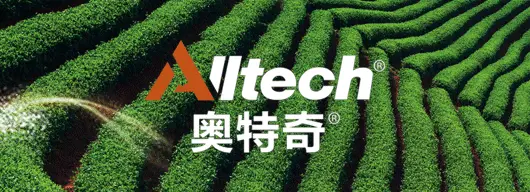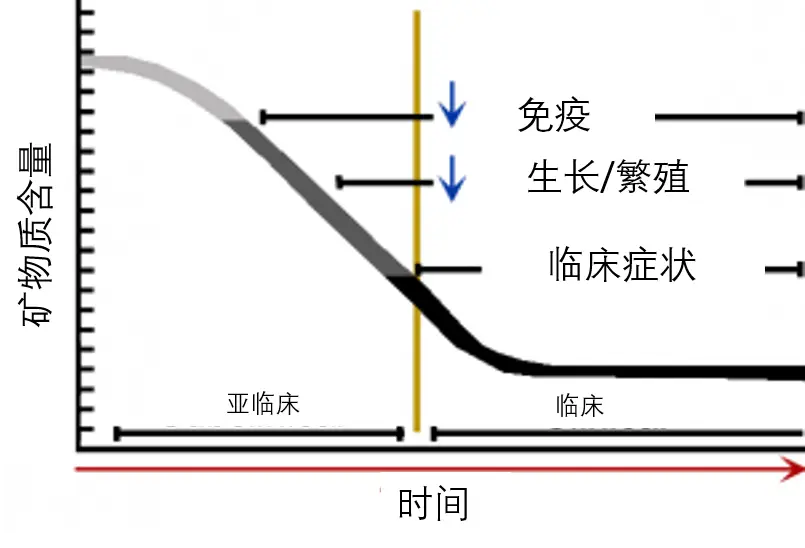牛多久了补硒一次(牛多久了补硒一次)

Scroll down for the English version
微量元素硒在肉牛营养中的应用
Roy Burris博士
韩佳璇 翻译
肉牛推广教授,美国肯塔基大学
元素硒是在1818年被发现的,但是硒在动物营养中的作用直到1950年左右才被理解。硒是一种必需的营养元素。硒在肉牛营养中被认作是一种痕量或微量的矿物质元素。肉牛的日粮中只需要添加千万分之一的硒(也就是0.1 ppm)。农作物或饲草能够富集土壤中的硒。尽管有些地区由于土壤中硒含量较高导致饲料原料中的硒超标产生毒性,但是在一些地区饲料中的硒含量不足很难满足动物的营养需要。
什么是硒?
硒是一种微量矿物质元素。它能够与蛋白结合形成硒蛋白。硒蛋白是一种重要的抗氧化酶。其中一种被人熟知的抗氧化酶就是谷胱甘肽过氧化物酶。含硒的抗氧化酶的主要功能是阻止自由基产生细胞损伤。自由基是在有氧代谢过程中产生的副产物,能够影响免疫系统使机体产生健康问题。
硒缺乏的症状是什么?
典型的硒和维生素E缺乏的症状是白肌病,主要表现是心肌变性坏死。好的营养专家都知道,很多潜在的问题在动物表现出临床缺乏症状之前已经发生了,例如,免疫、生长和繁殖性能的功能性损伤。
如下图所示,在临床症状显示之前,免疫、生长和繁殖的功能已经遭到了损伤。举个例子来说,肉牛在接种疫苗后不会表现出明显的免疫反应,但是它的免疫系统抵抗力在一段时间内是降低的。所以,防患于未然,不要等到出现了临床症状的时候再去想着在日粮中添加微量元素。

日粮中硒的来源
植物包括牧草和谷物是日粮中硒的主要来源。植物中硒的含量取决于土壤中硒的含量和生物学效价。在硒贫瘠土壤上生长的植物其硒的含量也会比较低。美国的西北地区、五大湖区、西海岸、东部沿海以及东南地区都是硒缺乏的地区,因此该地区的牧场可能面临硒缺乏的问题。
肉牛需要0.1 ppm (也就是每千克饲料要含0.1 mg的硒)来满足它们每天的需要量。在硒贫瘠地区生长的牧草和谷物其硒的含量往往不足(80%以上的牧草和谷物中硒的含量低于0.05 ppm)。美国肯塔基州就属于硒贫瘠的地区。这个地区的牧场中硒缺乏的现象比较常见(血液中硒的含量低于0.08 ppm)。
影响牧草中硒含量的一个很重要的因素是土壤的pH值。通常生长在酸性土壤中的植物比生长在碱性土壤中的植物吸收的硒要少。另外一个影响植物利用硒的因素是土壤中硫的含量。硫和硒的化学性质接近,在植物的吸收过程中容易产生拮抗效应。因此,在高硫含量土壤中生长的植物,其硒的含量要偏低。土壤施用硫酸盐肥料也会降低植物中硒的含量。这虽然不会直接影响作物的产量,但会影响放牧的效果。
我们应该如何应对低硒日粮?
肉牛日粮中需要0.1 ppm 的硒来满足每日的营养需要量。因此,硒贫瘠地区的牧场日粮中需要添加额外的硒来满足硒的需要量。给牛补充硒可以通过补饲添砖。美国食品药品监督管理局(FDA)允许补饲矿物质元素的添砖中硒的含量不超过120 ppm,这样的添砖能够为牛提供每天不超过3毫克的硒。
添砖的说明书中一般会标注硒摄入量的推荐值,每天硒的摄入量应该在3毫克左右。例如,每天摄入3盎司(约为85克)的添砖中硒的含量为35 ppm。每天摄入4盎司(约为113克)的添砖中硒的含量要降低到26 ppm以达到每头牛每天3毫克硒的摄入量。
硒的形式有哪几种?
通常日粮中添加的硒是以无机硒的形式添加,比如亚硒酸钠或硒酸钠。植物中的硒往往是与氨基酸螯合形式的有机硒,例如硒代蛋氨酸或硒代半胱氨酸。因此有人会猜想是不是有机硒比无机硒更难获得。
近期,富集硒的酵母已经被FDA批准使用。酵母硒中的硒主要是硒代蛋氨酸。亚硒酸钠主要是因为价格便宜而被普遍使用。有机硒要替代无机硒需要更可靠的来源以及更高的利用效率。
有机硒的优势有哪些?
肯塔基州的研究人员开展了后备母牛单独添加硒的试验。试验分三组,包括不添加硒的对照组,无机硒组(亚硒酸钠),有机硒组(酵母硒产品)。有机硒和无机硒组的添加量均为3毫克每头牛每天。
与不添加硒的对照组相比,添加有机硒和无机硒均能提高血液、红细胞和肝脏样品中硒的含量。但是,有机硒添加组的组织样品中硒的含量比无机硒添加组的高。肝脏样品的基因分析结果表明,有至少80种mRNA的表达受硒形式(有机硒还是无机硒)的影响。
试验发现了三组硒添加相关的基因:有机硒相关的基因,无机硒相关的基因,和与硒形式独立相关的基因。既然硒的形式会影响基因的表达,那么有必要去研究一下两种混合形式硒的添加效果,也就是50%有机硒加50%无机硒总共3毫克每天的添加量。另外,也有必要去研究添加硒引起肝脏中特定表达的相关基因。
一个长期的试验(试验期224天)研究了有机硒和无机硒混合添加对后备牛组织样品中硒含量的影响。试验分为四组:无添加的对照组,无机硒组,有机硒组,1:1有机硒和无机硒混合添加组。试验结果表明,有机硒组和混合添加组血液和肝脏中硒的含量要高于无机硒总。此外,三个硒添加组的含量均高于对照组。
另外的一个长达3年的试验是在放牧状态下研究硒对母牛的影响。硒是以添砖的形式添加。添砖中硒的含量为35 ppm。试验分三组,无机硒组(亚硒酸钠),有机硒组(酵母硒),和1:1的混合添加组。试验结果表明,硒的添加能够影响母牛和犊牛血液中硒的含量。母牛血液中硒的含量在三个组中都是充足的,但是无机硒组的犊牛血液中硒的含量存在不足的情况。
对低硒水平日粮的建议是什么?
首先,要确保牛在生长的各个阶段日粮中都有足够的矿物质元素。在硒缺乏的地区,我建议每头牛每天添加3毫克的硒。基于我们的研究结果,我倾向于添加50%的亚硒酸钠和50%的有机硒(例如酵母硒)。
如果你的牛每天能够摄入3到4盎司(85-113克)的添砖,那么添砖中硒的含量要在26到35 ppm之间。因为硒的形式对免疫和生长有不同的影响,所以硒的添加形式可以是一半无机硒和一半有机硒。
Selenium in Beef Cattle Nutrition
Dr. Roy Burris
Beef Extension Professor
University of Kentucky
Published on: Aug 21, 2020
Selenium (Se) was discovered in 1818 but its role in animal nutrition wasn’t understood until the 1950’s when Se was identified as an essential nutrient. Selenium is thought of as a trace or micro mineral in beef cattle diets. Beef cattle only require 0.10 parts per million (ppm) of Se in the total diet (not the mineral supplement). Although plants in some parts of the country can contain toxic levels of Se, forages grown in many parts of the country do not contain adequate levels of Se for optimum animal performance.
What is Selenium?
Selenium is a trace element (mineral) which is incorporated into proteins to make selenoproteins, which are important antioxidant enzymes. One of the most important of these is an enzyme known as glutathione peroxidase. The antioxidant properties of Se-inclusive enzyme systems help prevent cellular damage from free radicals. Free radicals are natural by-products of oxygen metabolism and a functional immune system that may contribute to the development of health problems.
What are the deficiency symptoms?
The classic clinical deficiency of Se and Vitamin E is white muscle disease which is myodegeneration of the heart muscle. However, as all good managers know, there are a lot of “unseen” problems in a nutritional deficiency before cattle exhibit clinical signs – such as decreased immunity, growth and fertility.
As indicated in the chart, immunity, growth and reproduction can be impaired before clinical symptoms appear. For example, cattle that have a compromised immune system may not mount an immune response despite being vaccinated for various diseases. Do not wait until clinical signs appear to supply trace minerals to cattle diets.
Dietary sources of selenium
Plants (forage and grain crops) are the major dietary source of Se. The Se content of plants is influenced by the concentration and availability of Se in the soil. Feedstuffs grown in Se-deficient areas are poor sources of Se. Areas in the U.S. like the Northwest, Great Lakes Region, West Coast, Eastern Seaboard and the Southeast may have low Se soils where deficiencies can be a problem.
Beef cattle require 0.1 ppm (mg/kg) of Se in the diet to meet their daily requirements. Much of the forages and grain grown in certain areas of the U.S. are at levels which allow those areas to be classified as low (where 80% of all forage and grain contains less than 0.05 ppm of Se). The Southeast (like Kentucky) is classified as low to variable. However, beef cattle operations in this region seem to have a high percentage of Se-deficient (less than 0.08 ppm Se in whole blood) animals.
An important factor affecting Se content of forages is soil pH. In general, plants grown in acid soil will absorb less Se than plants grown in alkaline soils. Another factor is the concentration of sulfur (S) in the soil. Se and S are chemically similar and compete for absorption by the plant. Thus, high levels of S in the soil may lower the Se content of the forage. Sulfate fertilizers can decrease the Se content of plants, which may not hurt the plants but can have a detrimental effect on cattle that graze them.
How do we overcome low
dietary levels of Se?
Cattle require 0.1 ppm Se in their diet to meet their daily requirement, so supplemental Se is needed for diets grown on low-Se soils. Supplemental Se is generally supplied to cattle in a free-choice salt/mineral supplement. The FDA allows for up to 120 ppm Se, regardless of source, to be added to the mineral supplement for free-choice feeding to provide a maximum of 3 mg per head daily.
Feedtags on mineral supplements will generally indicate the expected level of consumption and Se is added to provide 3 mg at that level of intake. For example, at an indicated level of intake of 3 oz per head per day, the mineral supplement may contain 35 ppm Se. At 4 oz intake the Se level would be reduced to 26 ppm to stay for the 3 mg per head daily level.
What about the form of Se?
Se is usually added to the feed in inorganic forms as sodium selenite or selenate. Se is usually found in plants combined with amino acids – selenomethionine and selenocysteine so it is logical to wonder if these “organic” forms of Se might not be more available to the animal than the “inorganic” (like sodium selenite) form.
Recently, Se enriched yeast, in which selenomethionine is the predominant form of Se, has become available and has been approved for use by the FDA. Sodium selenite is used primarily because it is less expensive. Organic forms of Se need to be more available and/or effective in order to be an economic alternative to sodium selenite.
Are there any advantages for
Organic Se?
Researchers at the Kentucky station conducted a trial with individually-fed beef heifers which received no Se, inorganic Se (sodium selenite) or organic Se (Sel-Plex®) at the 3 mg/hd/day rate.
More Se was found in jugular whole blood, red blood cells and biopsied liver tissue of the heifers receiving either form of Se than in the unsupplemented heifers. However, organic Se animals had more Se in these tissues than calves which were receiving sodium selenite. Analyses of liver tissue gene expression revealed that the content of at least 80 mRNA was affected by the form of Se.
Three Se supplement-dependent gene groups were identified: ISe-dependent, OSe-dependent and Se form-independent. Since the form of Se affects genetic expression differently, it made sense to look at a mixture of the two forms – with 50% of the 3 mg per day coming from each source. Also, all forms of Se were associated with unique liver gene expression profiles.
A long-term trial (224 days) was conducted with growing beef heifers to see what effect an equal blend of ISe:OSe would have on Se tissue concentrations. Calves received no Se, Inorganic Se, Organic Se or 1:1 Mixture of OSe and ISe. More Se was found in whole blood and liver of the calves receiving the mix or the organic Se than those receiving the inorganic Se – and all were greater than the controls.
Additional trials have been conducted including a three year study with cows on pasture with free individual access to one of the following treatments containing 35 ppm of Se – inorganic (sodium Selenite), organic (Sel-Plex®) or a 1:1 mixture of the two. Cow Se treatment differentially affected both cow and suckling calf Se blood concentrations resulting in adequate concentrations for all cows but inadequate concentrations for the calves of cows which received the inorganic Se (sodium selenite).
So what is your recommendation
to low Se levels?
First – keep a good mineral mix available to all cattle – at all times. In Se-deficient areas, I recommend that we feed Se at the 3 mg level (max. allowed by FDA). Based on our research, I would prefer that Se be 50 percent sodium selenite and 50 percent organically-derived (e.g., Sel-Plex®).
So – if your cows consume 3 to 4 ounces of a good mineral supplement daily – it should contain 26 to 35 ppm Se with half from organic and half from inorganic forms of Se since both forms elicit different responses in growth and immunity.
继续阅读
- 暂无推荐

